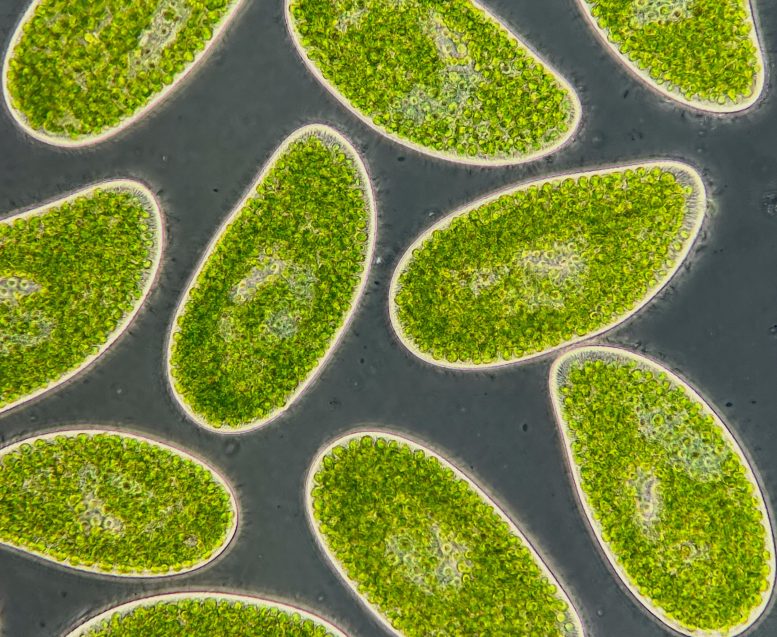
Found in lakes and rivers worldwide, single-celled creatures like these Paramecium bursaria can both eat and photosynthesize. Microbes like this play a double role in climate change, releasing or absorbing carbon dioxide — the heat-trapping greenhouse gas that is the primary driver of warming — depending on whether they rely on an animal-like lifestyle or a plant-like lifestyle. Credit: Daniel J. Wieczynski, Duke University
Increased heat levels might drive oceanic plankton and other unicellular organisms toward a carbon threshold, which could potentially exacerbate global warming. However, recent studies suggest that it might be feasible to identify early warning signs before these organisms reach that critical point.
A group of scientists researching a widespread yet frequently overlooked class of microbes have discovered a climate feedback loop that might intensify global warming. However, this finding comes with a silver lining: it could also be an early warning signal.
Utilizing a computer simulation, researchers from Duke University and the University of California, Santa Barbara, have demonstrated that a significant majority of global oceanic plankton, along with numerous unicellular organisms inhabiting lakes, peatlands, and other ecosystems, might reach a tipping point. Here, instead of absorbing carbon dioxide, they begin to do the opposite. This change is a result of the way their metabolism responds to warming.
Because carbon dioxide is a greenhouse gas, that in turn could drive up temperatures further — a positive feedback loop that could lead to runaway change, where small amounts of warming have an outsized impact.
But by carefully monitoring the abundances of these organisms, we might be able to anticipate the tipping point before it gets here, the researchers report in a study published June 1 in the journal Functional Ecology.
In the new study, researchers focused on a group of tiny organisms called mixotrophs, so named because they mix up two modes of metabolism: they can photosynthesize like a plant or hunt food like an animal, depending on conditions.
“They’re like the Venus fly traps of the microbial world,” said first author Daniel Wieczynski, a postdoctoral associate at Duke.
During photosynthesis, they soak up carbon dioxide, a heat-trapping greenhouse gas. And when they eat, they release carbon dioxide. These versatile organisms aren’t considered in most models of global warming, yet they play an important role in regulating climate, said senior author Jean P. Gibert of Duke.
Most of the plankton in the ocean — things like diatoms, dinoflagellates — are mixotrophs. They’re also common in lakes, peatlands, in damp soils, and beneath fallen leaves.
“If you were to go to the nearest pond or lake and scoop a cup of water and put it under a microscope, you’d likely find thousands or even millions of mixotrophic microbes swimming around,” Wieczynski said.
“Because mixotrophs can both capture and emit carbon dioxide, they’re like ‘switches’ that could either help reduce climate change or make it worse,” said co-author Holly Moeller, an assistant professor at the University of California, Santa Barbara.
To understand how these impacts might scale up, the researchers developed a mathematical model to predict how mixotrophs might shift between different modes of metabolism as the climate continues to warm.
The researchers ran their models using a 4-degree span of temperatures, from 19 to 23 degrees Celsius (66-73 degrees Fahrenheit). Global temperatures are likely to surge 1.5 degrees Celsius above pre-industrial levels within the next five years, and are on pace to breach 2 to 4 degrees before the end of this century.
The analysis showed that the warmer it gets, the more mixotrophs rely on eating food rather than making their own via photosynthesis. As they do, they shift the balance between carbon in and carbon out.
The models suggest that, eventually, we could see these microbes reach a tipping point — a threshold beyond which they suddenly flip from carbon sink to carbon source, having a net warming effect instead of a cooling one.
This tipping point is hard to undo. Once they cross that threshold, it would take significant cooling — more than one degree Celsius — to restore their cooling effects, the findings suggest.
But it’s not all bad news, the researchers said. Their results also suggest that it may be possible to spot these shifts in advance, if we watch out for changes in mixotroph abundance over time.
“Right before a tipping point, their abundances suddenly start to fluctuate wildly,” Wieczynski said. “If you went out in nature and you saw a sudden change from relatively steady abundances to rapid fluctuations, you would know it’s coming.”
Whether the early warning signal is detectable, however, may depend on another key factor revealed by the study: nutrient pollution.
Discharges from wastewater treatment facilities and runoff from farms and lawns laced with chemical fertilizers and animal waste can send nutrients like nitrate and phosphate into lakes and streams and coastal waters.
When Wieczynski and his colleagues included higher amounts of such nutrients in their models, they found that the range of temperatures over which the telltale fluctuations occur starts to shrink until eventually the signal disappears and the tipping point arrives with no apparent warning.
The predictions of the model still need to be verified with real-world observations, but they “highlight the value of investing in early detection,” Moeller said.
“Tipping points can be short-lived, and thus hard to catch,” Gibert said. “This paper provides us with a search image, something to look out for, and makes those tipping points — as fleeting as they may be — more likely to be found.”
Reference: “Mixotrophic microbes create carbon tipping points under warming” by Daniel J. Wieczynski, Holly V. Moeller and Jean P. Gibert, 31 May 2023, Functional Ecology.
DOI: 10.1111/1365-2435.14350
The study was funded by the Simons Foundation, the National Science Foundation, and the U.S. Department of Energy.









The much used, but erroneous concept of a Tipping Point only applies to extinctions, from which recovery is impossible. All other changes are recoverable. If Tipping Points involving climate were possible, surely we would be stuck in one now after 4.5 billion years of colder and warmer climates.
They talk about the simulation as though the climate on Earth were uniform and homogeneous. There are an infinite number of climates that vary continuously with latitude and elevation over the whole surface and change with time as plate tectonics raises mountain ranges and erosion reduces them to peneplaines.
“Global temperatures are likely to surge 1.5 degrees Celsius above pre-industrial levels within the next five years, and are on pace to breach 2 to 4 degrees before the end of this century.”
Wild speculation for which there are many reasons to question the claim.